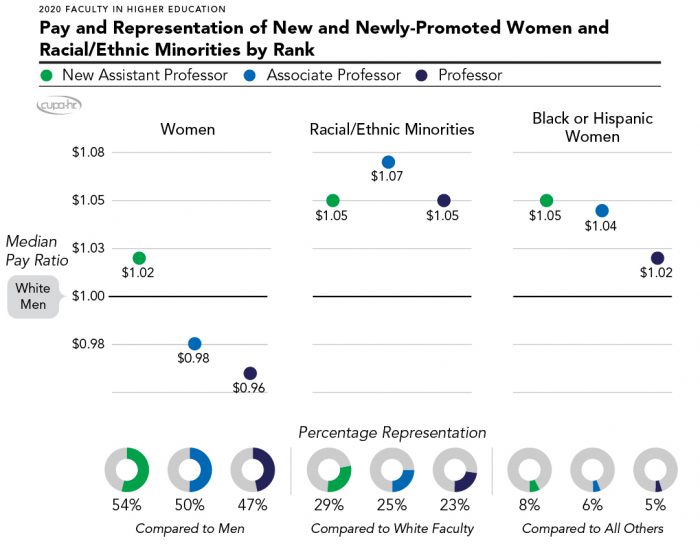PRESS RELEASE
FOR IMMEDIATE RELEASE
March 25, 2020
New Faculty Report Highlights Ongoing Inequalities in the Representation, Pay, and Promotion of Women and Minorities
The representation of both women and minorities decreases with progression in rank, according to the 2020 CUPA-HR Faculty in Higher Education Report released today. This decrease is not limited to faculty who were promoted long ago; the decrease is seen even in faculty promoted within the past year.

The data show that women beginning their careers are paid equitably and represent more than half (54 percent) of new assistant professors. However, in the past year, new promotions to both associate and full professor levels accompany increasing gaps in pay, with women newly promoted to full professor making just $0.83 on the dollar compared to White men. In addition, the representation of women decreases with each increase in rank, from 54 percent of new hires to 47 percent of new promotions to full professor. The same pattern holds for new and newly-promoted women of color, except that decreases in their salaries do not fall below the level of pay equity.
Nearly half (47 percent) of all full-time faculty are women, and more than one-fifth (22 percent) are racial/ethnic minorities. In contrast, only 43 percent of department heads/chairs are women, and only 16 percent are minority.
Other key findings include:
- Tenure-track faculty received the largest median increase in salary (1.93 percent) than they have since 2015-16.
- The disciplines with the highest median salaries for new assistant professors (both tenure track and non-tenure teaching) are Business, Computer Science, and Engineering. The discipline with the most new hires (n = 1,300) in 2019-20 is Health Professions. The discipline with the most hiring growth (30 percent) in the past year is Agriculture.
- More than three-fourths of full-time faculty hold doctoral degrees, and doctoral institutions have the highest percentage (83 percent) of doctoral-degree faculty. Almost nine of the 10 tenure-track faculty hold a doctoral degree, whereas only five of 10 non-tenure teaching faculty hold a doctoral degree.
- The discipline of Family/Consumer Sciences has the highest percentage of female faculty. The discipline of Area/Cultural Studies has the highest percentage of minorities.
- The discipline with the greatest percentage of faculty over age 55 is Theology/Religion, and the discipline with the lowest percentage of faculty over age 55 is Parks, Rec, and Fitness.
- The greatest factor that influences adjunct faculty pay is the entity that sets adjunct pay. When pay is set at the level of the institution (a single entity at the institution or collective bargaining agreement), adjunct pay tends to be lower. When it is set at the level of the department or program in which the adjunct teaches, pay tends to be higher.
A total of 273,016 full-time faculty positions were reported for this year’s survey. In total, 853 institutions provided incumbent-level data for full-time faculty, and 395 of those institutions provided aggregate data for adjunct faculty. CUPA-HR is the first workforce survey to collect data using the 2020 Classification of Instructional Programs (CIP) Codes. To learn more about the Faculty in Higher Education Survey, read the overview. Salaries, demographic comparisons and detailed trend information are available in the full report.
About CUPA-HR
CUPA-HR is the recognized authority on compensation surveys for higher education, with its salary surveys designed by higher ed HR professionals for higher ed HR professionals and other campus leaders. CUPA-HR’s Faculty in Higher Education Survey is the only faculty survey that provides data for the current academic year, maintains institution anonymity, collects data by rank and specific discipline, and collects comprehensive demographic data. Learn more about CUPA-HR research.
CUPA-HR is higher ed HR. We serve higher education by providing the knowledge, resources, advocacy and connections to achieve organizational and workforce excellence. Headquartered in Knoxville, Tennessee, and serving over 30,000 HR professionals and other campus leaders at more than 2,000 member institutions and organizations around the country and abroad, the association offers learning and professional development programs, higher education salary and benefits data, extensive online resources and just-in-time regulatory and legislative information.
Contact Information
Erin Rosolina
Marketing Manager – Communications and Marketing
[email protected]


